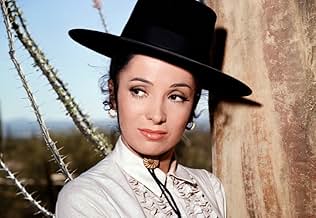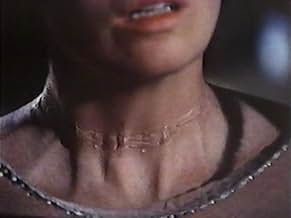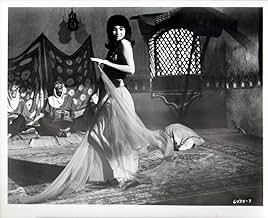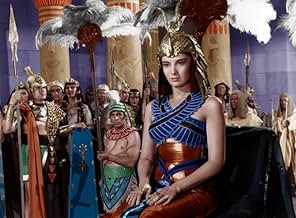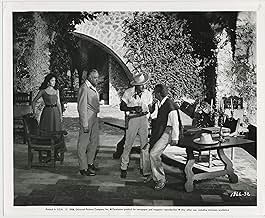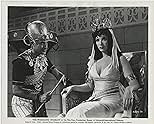Linda Cristal(1931-2020)
- Actress
Argentinian leading lady Marta Victoria Moya Peggo Burges was one of three siblings, born in Buenos Aires to a French father and Italian mother. When she was five years of age, her father, a publisher, fled with his family to Montevideo, Uruguay, where they went on to live for several years in somewhat reduced circumstances. According to one of two conflicting stories, her father had gotten into "into conflict with a criminal gang". According to another, he may have fallen foul of the ruling political elite. Whatever the case, both parents died prematurely in what was possibly a suicide pact (in their car of carbon monoxide poisoning) by the time Linda was 13.
Educated at the Conservatoria Franklin in Uruguay, she studied voice and piano. A brief marriage to the Argentinian actor Tito Gómez ended in an annulment after just five days and Linda briefly toyed with the idea of entering a convent (as had several of her aunts). Fate, of course, intervened. While vacationing in Mexico with her older brother, she was 'discovered' by the film producer and director Miguel Alemán Velasco, who also happened to be the son of the country's ruling president. Signed under contract, she adopted the moniker Linda Cristal and made several Spanish language films which soon established her as one of Mexico's rising stars. Conscious of her potential and hoping to break into Hollywood, she decided to learn English as her fourth language (already fluent in Spanish, French and Italian) and subsequently made her American film debut with a small role in the Dana Andrews western Comanche (1956). A dispute over the non-payment of her wages and a car accident in 1956 then led to a brief hiatus in her career.
Fast forward three years and a bit of publicity (she was named "Motion Picture Sweater Queen" in 1958) and Linda was lured back to Hollywood by Universal to again hit the saddle in a couple of back-to-back minor westerns, The Last of the Fast Guns (1958) and The Fiend Who Walked the West (1958). In between attempts to break free from typecasting as decorative Latinas (La donna dei faraoni (1960), Panic in the City (1968)) -- a metamorphosis which never happened -- she at least got herself noticed by some high profile people in the business (ie. John Wayne) and was able to thus secure roles in better productions like The Alamo (1960) and Two Rode Together (1961). While her motion picture career was at an impasse, she learned of producer David Dortort casting for the part of Victoria Montoya in the upcoming TV series The High Chaparral (1967). Invited to an audition, she found the set script as too saccharine and bland. Audaciously improvising, she re-imagined her character as more tempestuous, resourceful and proud, later saying in an interview that she knew the producers "were looking for a heroine with fire and spunk". Having secured the coveted role, she made it her own for four seasons (1967-71), ultimately winning two Primetime Emmy nominations and netting her the Golden Globe Award in 1970 as Best Actress in a TV Drama.
After High Chaparral ceased production in 1971, Linda made guest appearances in a handful of TV shows and played a Mexican migrant worker and union leader in Charles Bronson's robust action film Mr. Majestyk (1974). She later worked for some time as a realtor, presided over her own import/export business and invested wisely to become financially very well-off. She made a final comeback to acting as the mistress of a mob boss in the daytime soap General Hospital (1963), eventually calling it quits in 1988. Linda spent her remaining years between residences in Beverly Hills, Palm Springs and Buenos Aires and passed away at her Beverly Hills home on June 27 2020 at the age of 89.
Educated at the Conservatoria Franklin in Uruguay, she studied voice and piano. A brief marriage to the Argentinian actor Tito Gómez ended in an annulment after just five days and Linda briefly toyed with the idea of entering a convent (as had several of her aunts). Fate, of course, intervened. While vacationing in Mexico with her older brother, she was 'discovered' by the film producer and director Miguel Alemán Velasco, who also happened to be the son of the country's ruling president. Signed under contract, she adopted the moniker Linda Cristal and made several Spanish language films which soon established her as one of Mexico's rising stars. Conscious of her potential and hoping to break into Hollywood, she decided to learn English as her fourth language (already fluent in Spanish, French and Italian) and subsequently made her American film debut with a small role in the Dana Andrews western Comanche (1956). A dispute over the non-payment of her wages and a car accident in 1956 then led to a brief hiatus in her career.
Fast forward three years and a bit of publicity (she was named "Motion Picture Sweater Queen" in 1958) and Linda was lured back to Hollywood by Universal to again hit the saddle in a couple of back-to-back minor westerns, The Last of the Fast Guns (1958) and The Fiend Who Walked the West (1958). In between attempts to break free from typecasting as decorative Latinas (La donna dei faraoni (1960), Panic in the City (1968)) -- a metamorphosis which never happened -- she at least got herself noticed by some high profile people in the business (ie. John Wayne) and was able to thus secure roles in better productions like The Alamo (1960) and Two Rode Together (1961). While her motion picture career was at an impasse, she learned of producer David Dortort casting for the part of Victoria Montoya in the upcoming TV series The High Chaparral (1967). Invited to an audition, she found the set script as too saccharine and bland. Audaciously improvising, she re-imagined her character as more tempestuous, resourceful and proud, later saying in an interview that she knew the producers "were looking for a heroine with fire and spunk". Having secured the coveted role, she made it her own for four seasons (1967-71), ultimately winning two Primetime Emmy nominations and netting her the Golden Globe Award in 1970 as Best Actress in a TV Drama.
After High Chaparral ceased production in 1971, Linda made guest appearances in a handful of TV shows and played a Mexican migrant worker and union leader in Charles Bronson's robust action film Mr. Majestyk (1974). She later worked for some time as a realtor, presided over her own import/export business and invested wisely to become financially very well-off. She made a final comeback to acting as the mistress of a mob boss in the daytime soap General Hospital (1963), eventually calling it quits in 1988. Linda spent her remaining years between residences in Beverly Hills, Palm Springs and Buenos Aires and passed away at her Beverly Hills home on June 27 2020 at the age of 89.



